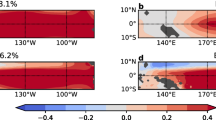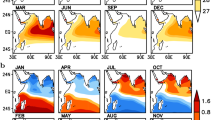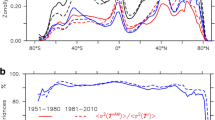Abstract
The determination of specific sea surface temperature (SST) patterns from large-scale gridded SST-fields has widely been done. Often principal component analysis (PCA) is used to condense the SST-data to major patterns of variability. In the present study SST-fields for the period 1950–2003 from the area 20°S to 60°N are analysed with respect to SST-regimes being defined as large-scale oceanic patterns with a regular and at least seasonal occurrence. This has been done in context of investigations on seasonal predictability of Mediterranean regional climate with large-scale SST-regimes as intended predictors in statistical model relationships. The SST-regimes are derived by means of a particular technique including multiple applications of s-mode PCA. Altogether 17 stationary regimes can be identified, eight for the Pacific Ocean, five for the Atlantic Ocean, two for the Indian Ocean, and two regimes which show a distinct co-variability within different ocean basins. Some regimes exist, with varying strength and spatial extent, throughout the whole year, whereas other regimes are only characteristic for a particular season. Several regimes show dominant variability modes, like the regimes associated with El Niño, with the Pacific Decadal Oscillation or with the North Atlantic Tripole, whereas other regimes describe little-known patterns of large-scale SST variability. The determined SST-regimes are subsequently used as predictors for monthly precipitation and temperature in the Mediterranean area. This subject is addressed in Part II of this paper.




Similar content being viewed by others
References
Alexander MA, Deser C, Timlin MS (1999) The reemergence of SST anomalies in the North Pacific Ocean. J Clim 12:2419–2433
Alexander MA, Bladé I, Newman M, Lanzante JR, Lau N-C, Scott JD (2002) The atmospheric bridge: the influence of ENSO teleconnections on air–sea interaction over the global oceans. J Clim 15:2205–2231
An S-I (2009) A review of interdecadal changes in the nonlinearity of the El Niño-Southern Oscillation. Theor Appl Climatol 97:29–40
Barnston AG, Smith TM (1996) Specification and prediction of global surface temperature and precipitation from global SST using CCA. J Clim 9:2660–2697
Bland JM, Altman DG (1986) Statistical methods for assessing agreement between two methods of clinical measurement. Lancet 8476:307–310
Cassou C, Deser C, Terray L, Hurrell JW, Drévi M (2004) Summer sea surface temperature conditions in the North Atlantic and their impact upon the atmospheric circulation in early winter. J Clim 17:3349–3363
Colman A, Davey M (1999) Prediction of summer temperature, rainfall and pressure in Europe from preceding winter North Atlantic Ocean temperature. Int J Climatol 19:513–536
Conte M, Giuffrida S, Tedesco S (1989) The Mediterranean oscillation: impact on precipitation and hydrology in Italy. In: Proceedings of the conference on climate and water. Publications of the Academy of Finland, Helsinki, pp 121–137
Czaja A, Frankignoul C (2002) Observed impact of Atlantic SST anomalies on the North Atlantic oscillation. J Clim 15:606–623
Czaja A, Marshall J (2001) Observations of atmosphere–ocean coupling in the North Atlantic. Quart J Roy Meteorol Soc 127:1893–1916
Deser C, Blackmon ML (1993) Surface climate variations over the North Atlantic Ocean during winter: 1900–1989. J Clim 6:1743–1753
Deser C, Blackmon ML (1995) On the relationship between tropical and north Pacific sea surface temperature variations. J Clim 8:1677–1680
Deser C, Timlin MS (1997) Atmosphere–ocean interaction on weekly timescales in the North Atlantic and Pacific. J Clim 10:393–408
Dix MR, Hunt BG (1995) Chaotic influences and the problem of deterministic seasonal prediction. Int J Climatol 15:729–752
Emery WJ, Hamilton K (1985) Atmospheric forcing of interannual variability in the Northeast Pacific Ocean: connections with El Niño. J Geophys Res 90(C1):857–868
Enfield DB, Mestas-Nunez AM, Trimble PJ (2001) The Atlantic multidecadal oscillation and its relationship to rainfall and river flows in the continental U.S. Geophys Res Lett 28:2077–2080
Fuglister FC (1951) Annual variations in current speeds in the Gulf Stream system. J Mar Res 10:119–127
García-Serrano J, Losada T, Rodríguez-Fonseca B, Polo I (2008) Tropical Atlantic variability modes (1979–2002). Part II. Time-evolving atmospheric circulation related to SST-forced tropical convection. J Clim 24:6476–6497
Häkkinen S, Mo KC (2002) The low-frequency variability of the Tropical Atlantic Ocean. J Clim 15:237–250
Hirst AC, Hastenrath S (1983) Atmosphere–ocean mechanisms of climate anomalies in the Angola–tropical Atlantic sector. J Phys Oceanogr 13:1146–1157
Hoerling MP, Hurrell JW, Xu T, Bates GT, Phillips AS (2004) Twentieth century North Atlantic climate change. Part II. Understanding the effect of Indian Ocean warming. Clim Dyn 23:391–405
Hogg NG, Johns WE (1995) Western boundary currents. U.S. National Report to International Union of Geodesy and Geophysics 1991–1994. Rev Geophys 33(Suppl):1311–1334
Houghton RW, Tourre YM (1992) Characteristics of low-frequency sea surface temperature fluctuations in the Tropical Atlantic. J Clim 5:765–772
Hwang S-O, Schemm J-K, Barnston A, Kwon W-T (2001) Long-lead seasonal forecast skill in far eastern Asia using canonical correlation analysis. J Clim 14:3005–3016
Keenlyside NS, Latif M (2007) Understanding equatorial Atlantic interannual variability. J Clim 20:131–142
Liu Z, Alexander M (2007) Atmospheric bridge, oceanic tunnel, and global climatic teleconnections. Rev Geophys 45:RG2005. doi:10.1029/2005RG000172
Lloyd-Hughes B, Saunders M (2002) Seasonal prediction of European spring precipitation from El Nino–Southern Oscillation and local sea-surface temperatures. Int J Climatol 22:1–14
Luis A, Kawamura H (2001) Characteristics of atmospheric forcing and SST cooling events in the Gulf of Mannar during winter monsoon. Remote Sens Environ 77:139–148
Mantua NJ, Hare SR, Zhang Y, Wallace JM, Francis RC (1997) A Pacific interdecadal climate oscillation with impacts on salmon production. Bull Am Meteorol Soc 78:1069–1079
Mason S, Mimmack G (2002) Comparison of some statistical methods of probabilistic forecasting of ENSO. J Clim 15:8–29
Miller AJ, Cayan DR, Barnett TP, Graham NE, Oberhuber JM (1994) The 1976–1977 climate shift of the Pacific Ocean. Oceanography 7:21–26
Moron V, Plaut G (2003) The impact of El Niño-southern oscillation upon weather regimes over Europe and the North Atlantic during boreal winter. Int J Climatol 23:363–379
Nakamura H, Lin G, Yamagata T (1997) Decadal climate variability in the North Pacific during the recent decades. Bull Am Meteorol Soc 78:2215–2225
Neelin JD, Battisti D, Hirst AC, Jin FF, Wakata Y, Yamagata T, Zebiak SE (1998) ENSO theory. J Geophys Res C104:14262–14290
Palmer TN, Zhaobo Sun (1985) A modelling and observational study of the relationship between sea surface temperature in the North-West atlantic and the atmospheric general circulation. Quart J Roy Meteorol Soc 111:947–975
Peng S, Robinson WA, Li S (2003) Mechanisms for the NAO responses to the North Atlantic SST Tripole. J Clim 16:1987–2004
Philipp A, Della-Marta PM, Jacobeit J, Fereday DR, Jones PD, Moberg A, Wanner H (2007) Long term variability of daily north atlantic-european pressure patterns since 1850 classified by simulated annealing clustering. J Clim 20(16):4065–4095
Rayner NA, Parker DE, Horton EB, Folland CK, Alexander LV, Rowell DP, Kent EC, Kaplan A (2003) Global analyses of sea surface temperature, sea ice, and night marine air temperature since the late nineteenth century. J Geophys Res 108:4407
Reynolds RW, Rayner NA, Smith TM, Stokes DC, Wang W (2002) An improved in situ and satellite SST analysis for climate. J Clim 15:1609–1625
Rodriguez-Fonseca B, Polo I, Serrano E, Castro M (2006) Evaluation of the North Atlantic SST forcing on the European and Northern African winter climate. Int J Climatol 26:179–191
Rodwell MJ, Rowell DP, Folland CK (1999) Oceanic forcing of the wintertime North Atlantic Oscillation and European climate. Nature 398:320–323
Rowell DP (1998) Assessing potential seasonal predictability with an ensemble of multidecadal GCM simulations. J Clim 11:109–120
Ruiz-Barradas A, Carton JA, Nigam S (2000) Structure of interannual-to-decadal climate variability in the Tropical Atlantic sector. J Clim 13:3285–3297
Seubert S, Jacobeit J (2007) Tropical influences on Mediterranean precipitation variability. Geophys Res Abstr 9
Smith TM, Reynolds RW (2003) Extended reconstruction of global sea surface temperatures based on COADS data (1854–1997). J Clim 16:1495–1510
Stephenson DB, Hannachi A, O`Neil A (2004) On the existence of multiple climate regimes. Quart J Roy Meteorol Soc 130:583–605
Trenberth KE (1990) Recent observed interdecadal climate changes in the Northern Hemisphere. Bull Am Meteorol Soc 71:993–998
Trenberth KE, Hurrell JW (1994) Decadal atmosphere–ocean variations in the Pacific. Clim Dyn 9:303–319
Trenberth KE, Branstator GW, Karoly D, Kumar A, Lau N-C, Ropelewski C (1998) Progress during TOGA in understanding and modeling global teleconnections associated with tropical sea surface temperatures. J Geophys Res 103(14):291–324
Wallace JM, Smith C, Jiang Q (1990) Spatial patterns of atmosphere–ocean interaction in the Northern Winter. J Clim 3:990–998
Wallace JM, Smith C, Bretherton CS (1992) Singular value decomposition of wintertime sea surface temperature and 500-mb height anomalies. J Clim 5:561–576
Wang B (1995) Interdecadel changes in El Nino onset in the last four decades. J Clim 8:267–285
Wang H, Fu R (2000) Winter monthly mean atmospheric anomalies over the North Pacific and North America associated with El Nino SSTs. J Clim 13:3435–3447
Watanabe M, Kimoto M (2000) On the persistence of decadal SST Anomalies in the North Atlantic. J Clim 13:3017–3028
Webster PJ, Moore AM, Loschnigg JP, Leben RR (1999) Coupled ocean-atmosphere dynamics in the Indian Ocean during 1997–1998. Nature 401:356–360
Woodruff SD, Diaz HF, Elms JD, Worley SJ (1998) COADS release 2 data and metadata enhancements for improvements of marine surface flux fields. Phys Chem Earth 23:517–527
Yuan Y, Yang H, Zhou W, Li C (2008) Influences of the Indian Ocean dipole on the Asian summer monsoon in the following year. Int J Climatol. doi:10.1002/joc.1678
Yamagata T, Behera SK, Rao SA, Guan Z, Ashok K, Saji HN (2003) Comments on “dipoles, temperature gradient, and tropical climate anomalies”. Bull Am Meteorol Soc 84:1418–1422
Yu J-Y, Lau KM (2005) Contrasting Indian Ocean SST variability with and without ENSO influence: a coupled atmosphere–ocean GCM study. Meteorol Atmos Phys 90:179–191
Yulaeva E, Schneider N, Pierce DW, Barnett TP (2001) Modeling of North Pacific climate variability forced by oceanic heat flux anomalies. J Clim 14:4027–4046
Zebiak SE (1993) Air–sea interaction in the equatorial Atlantic region. J Clim 6:1567–1586
Zhang Y, Norris JR, Wallace JM (1998) Seasonality of large-scale atmosphere–ocean interaction over the North Pacific. J Clim 11:2473–2481
Acknowledgments
Financial support was provided by the DFG (German Research Foundation) under contract JA 831/3-1.
Author information
Authors and Affiliations
Corresponding author
Rights and permissions
About this article
Cite this article
Hertig, E., Jacobeit, J. Predictability of Mediterranean climate variables from oceanic variability. Part I: Sea surface temperature regimes. Clim Dyn 36, 811–823 (2011). https://doi.org/10.1007/s00382-010-0819-x
Received:
Accepted:
Published:
Issue Date:
DOI: https://doi.org/10.1007/s00382-010-0819-x




